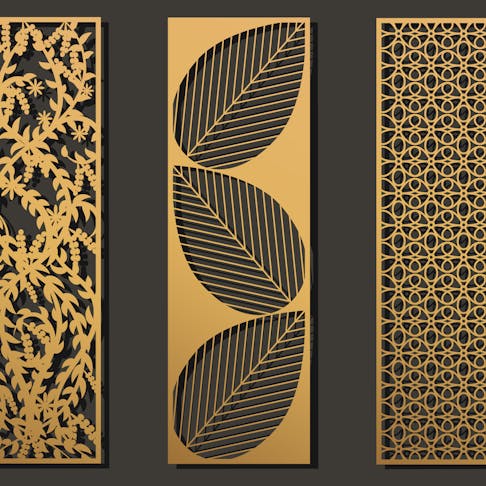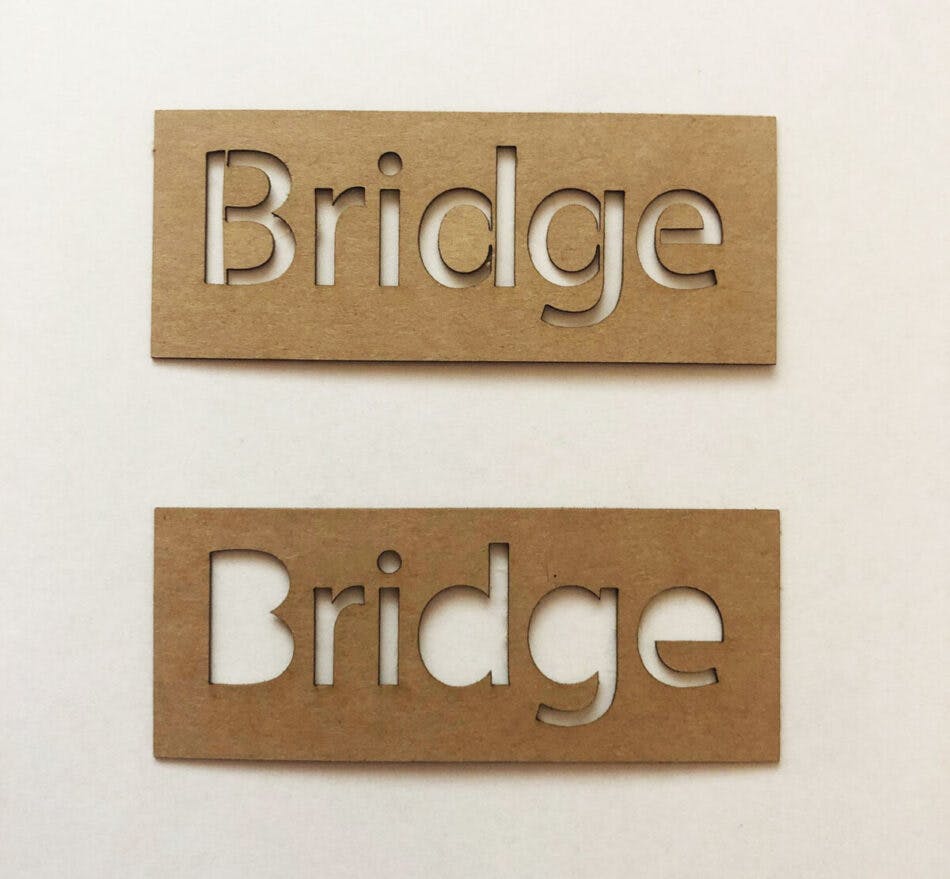
The 7 Advantages of Using Laser Cut Stencils

A stencil can be defined as a thin sheet of metal, plastic, cardboard, or even paper that has had characters or a pattern cut out of it. By applying ink or paint through the design's perforations, the cut-out design is transferred to a suitable surface. The main benefit of using a stencil is that you can quickly and easily produce the same letters or pattern by using it again and again. Although stencils can be created for single usage (e.g., stencils made from paper and cards), they are mostly created to be reused.
Laser cutting stencils, as the name suggests, are created on laser cutting machines to facilitate easily repeatable artwork or patterns. Compared to other stencil manufacturing processes, laser-cut stencils have the primary advantage of precision and durability. They also offer fast turnaround, exquisite detail, and reproducibility.
In this article, we’ll look at the advantages of using laser cutting stencils, each of which will be discussed in the subsequent sections. The list below covers the seven advantages associated with laser-cut stencils:
1. Repetition of Artwork Is Easy
Laser cutters are known for their precision and accuracy, which make them ideal for reproducing simple and complex designs alike. Laser cutters can be used for reproducing intricate design patterns if the correct settings and design principles are used. What’s more, laser cutters offer the added benefit of process automation, meaning the designs can be reproduced with accuracy and a fast turnaround, which results in cost savings for the manufacturer.
2. Ability To Recreate Artwork on Different Surfaces
Stencils are very versatile and can be used on a wide range of materials. Reusable stencils allow users to recreate their artwork on different surfaces and with different mediums. This can be particularly helpful for small business owners and marketing agencies looking for a way to present their brand consistently and cost-effectively.
3. Lowers the Required Level of Artistic Ability
Besides designing the stencil, there is no artistic ability required to create an aesthetic design from your stencil. If you are not familiar with vector design programs, you can hire a professional to create the pattern or text design for you, which you can then laser cut and use to reproduce the design on different surfaces without any artistic abilities.
4. Implementing Color Variations for the Same Design Is Simple
Because stencils can be reused, they also offer the option of making color variations to the same design. This is not the only color-related benefit that stencils offer. Stencils also offer the opportunity to create multi-color designs through multi-layer stencils. This means that you, as a user, are not limited to one-color designs and can bring in as many colors as you’d like through multiple layers.
5. Reduces the Cost of Making a Design More Appealing
Stencils are not only easy to use, but they are cost and time efficient. Stencils can be reused, and colors can be tweaked to a design by simply applying new colored paint to the stencil. Changing your brand or design can be done by simply cutting the new design into a stencil. Furthermore, it is easy to patch up your design if the design fades over time. This can be done by reapplying the stencil and matching it to the faded design before reapplying the color.
6. Learning How To Use Stencils for Laser Cutting Is Not Difficult
Laser-cut stencils are very easy to use. After the stencil has been cut, it is ready for use. Simply cover the surface you want to apply the artwork to with the stencil and then apply the paint to the gaps in the stencil. Be careful not to move the stencil when you apply the paint or to get paint underneath the stencil. Also, be sure to allow the leftover paint on the stencil sufficient time to dry before applying the stencil to another surface.
7. Simplifies Adding Artwork to Crafts, Packaging, and Home Decor To Improve Their Appearance
Stencils are popular in the home decor, packaging, and crafts industries due to their favorable characteristics like easy application, consistency, and reproducibility. They are also affordable and deliver aesthetic results.
What Materials Are Used for Laser Cut Stencils?
Materials that can be used to create laser-cut stencils include:
- Cardboard and Cardstock: These are budget-friendly options that are usually used for single-use designs.
- Mylar®: Mylar® stencils can be used for a wide range of applications, like signage, arts and crafts, branding and marketing, etc.
- Wood: Thin wood sheets can be used for rigid laser-cut stencils.
- Plastics and Materials Made From Plastic: Polyester and polypropylene are both popular options used to create stencils for signage in the construction industry for way signs.
- Vinyl Self-Adhesive Stencils: These stencils are handy for tricky surfaces.
To learn more, see our guide on What is Laser Cutting Used For.
How To Make a Stencil for Laser Cutting
The main step behind creating a laser-cut stencil comes down to the vector design. After the design has been made, the laser cutter settings can be adjusted to perform the cutting. Stencil designs can be divided into two categories: text-based stencils and graphic-based stencils. The steps to creating these stencils are discussed below:
- Create the Vector Design: All laser cutting processes require a vector design. To create text-based stencils, you can choose any Stencil Font to create the stencil that you like. However, if you have to use a specific font for branding or marketing reasons, it is important to tweak the text to include bridges to prevent the centerpieces from falling out. Letters that contain closed shapes, like “B”, “O”, or “P” require bridges to link the inner sections of the closed shapes to the outer section so that it doesn’t separate while cutting, as seen in Figure 1 below:
The difference between adding bridges to letters.
Image Credit: https://jackforge.com/laser-cutting-stencils/
Tags, or bridges, can be removed by painting them after the stencil has dried. Text artwork can be tagged in both RDWorks and LightBurn®, though LightBurn® makes the process simpler. As an alternative, you may carry out the same task using a vector drawing program like Inkscape™, and then import the result into your preferred laser software program.
For graphic-based pieces, the vector design can be somewhat tricky, depending on the complexity of the design. It can be more tricky to spot areas where the central parts may fall out. It can help to switch the layer mode from cut to fill to view the entire image and check for errors and to spot areas that are not closed.
- Set the Machine Settings: Set a few parameters like laser power and speed, cutting frequency, and airflow.
- Do a Test Run: Do a test run of the stencil cutting settings before doing the final piece. This ensures that all parameters are accurately set up to achieve the desired aesthetic.
- Final Cut: After performing the necessary modifications, start the final cut.
What Are the Disadvantages of Laser Cutting a Stencil?
The following are some drawbacks of utilizing stencils:
- Closed designs must be altered while making a stencil to stop the inner stencil parts from coming loose when being cut.
- Multiple stencils are required for layered artwork.
- If creating artwork exclusively with stencils, the color variance within a stenciled design may be constrained.
- To stop pigment or dye media from coloring outside of the specified region, the stencil must be properly secured to the surface.
- It can get pricey to buy stencils.
- Stencil design can be challenging.
To learn more, see our article on the Disadvantages of Using Stencil.
What Industries Use Laser Cut Stencils?
Laser-cut stencils are used in a wide range of industries, including:
- Marketing/Business for consistent brand representation and awareness.
- Construction and industrial industries use stencils for signage.
- Fiber optics.
- Arts and crafts.
- Packaging.
- Home Decor.
- Lighting.
- Aerospace and defense industries.
Is Mylar® Used for Stencil Making?
Yes. Mylar® is the most popular material used for laser-cut stencils. It is a strong, flexible material that is resistant to solvents and easy to clean—making it ideal for multi-use stencils. To learn more, see our guide on Mylar Cutting.
Summary
This article presented the advantages of laser cut stencils, explained each of them, and discussed why each is an advantage. To learn more about laser cut stencils, contact a Xometry representative.
Xometry provides a wide range of manufacturing capabilities, including sheet cutting and other value-added services for all of your prototyping and production needs. Visit our website to learn more or to request a free, no-obligation quote.
Copyright and Trademark Notices
- MYLAR® is a registered trademark of the DuPont Teijin Corporation.
- LightBurn® is a registered trademark of LightBurn Software, LLC.
- Inkscape™ is a trademark of The Inkscape Project (a member project of Software Freedom Conservancy).
Disclaimer
The content appearing on this webpage is for informational purposes only. Xometry makes no representation or warranty of any kind, be it expressed or implied, as to the accuracy, completeness, or validity of the information. Any performance parameters, geometric tolerances, specific design features, quality and types of materials, or processes should not be inferred to represent what will be delivered by third-party suppliers or manufacturers through Xometry’s network. Buyers seeking quotes for parts are responsible for defining the specific requirements for those parts. Please refer to our terms and conditions for more information.

